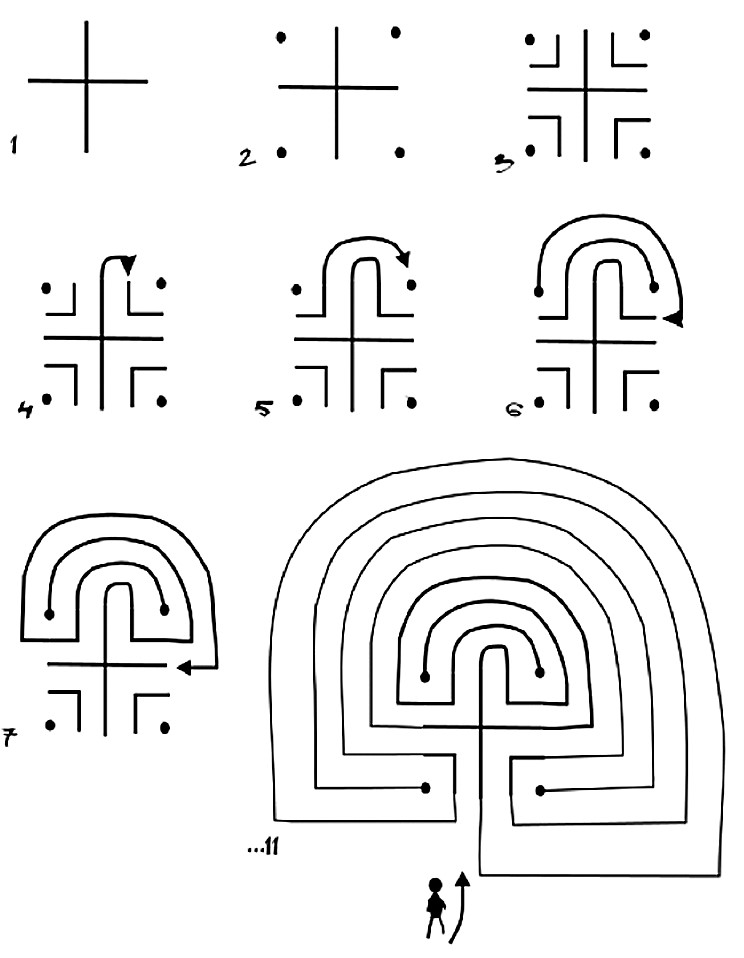Labyrinth as a way of active reflection
Newton’s First Law of Motion says that “every object in a state of uniform motion tends to remain in that state of motion unless an external force is applied to it”. We can facilitate the motion by strengthening or weakening our powers. In this article we invite you for your own learning assessment journey through a process which is happening while both the body and the mind are activated. We adopted the pattern of Labyrinth of Mother Earth (Dancing Queen) for this purpose.

Why did I choose this tool?
The labyrinth itself is a great developmental tool, from its construction, going through it, to its deconstruction.
How does this apply to being a trainer?
‘Effectiveness as a learner hinges on the ability to be versatile as a learner. To have a rich view of learning and a learning orientation which is in turn linked to the ability to plan, monitor and review one’s learning’ (Watkins, 2010). Labyrinth is just one example of the methods inducing metacognition and stimulating meta-learning.
Content:
By experiencing physical aspects of ourselves, we can learn about psychological and emotional aspects. Reflecting on and integrating these aspects can lead to profound shifts in the way we live our lives. By acknowledging that the mind and the body are linked, we gain power over our physical and emotional lives. (Crino 2009 p.11).
The labyrinth requires both: the body and the mind. The learner first needs to understand and learn the pattern and the design of the labyrinth and then walk through it.
Metacognition involves two distinct processes. Metacognitive knowledge is the knowledge the learner has about the task, their own cognitive abilities and the learning outcomes or goals. Metacognitive regulation involves a learner controlling the cognitive processes and strategies being used as the learners complete a task.
The method „labyrinth” may be used individually or in groups of learners.
For an individual, the process takes more time in building, and while going through labyrinth it may allow the learner deep insights, as there are no external distractions.
For the group, the construction phase often discloses the roles of group members, stimulates the process of decision making and is boosting the creativity.
Exercise:
Many practitioners claim that learners take great value from constructing and deconstructing the labyrinth themselves, rather than useing one that was already pre-build.
- Formulate your inquiry. What would you like to discover in the labyrinth?
For the purpose of learning to learn competence we would advise you to build a labyrinth answering the question: How do I learn? What would I like to achieve as a learner? - Construction phase:
- Choose a place for the labyrinth (most preferably outdoor, even though indoor is also possible). – Collect materials. Decide on materials (leafs, rice, stones, sand, tape, socks etc.) and the size of the labyrinth (min 6 meters square). When constructing, one should remember the track, which should allow individual walking.
- Reflection recording – something to memorize your thoughts: notebook, or digital voice recorder.
- Time: the construction phase may last 20 – 30 min, passage around 20 min, closure – 20 min.
Follow the pattern, step by step, start from a big cross on the floor, then mark the four points, add 4 lines in a shape of „L” and connect the lines and dots starting from a central line:

Passage phase:
When you are ready with the construction, the labyrinth opens, and from this moment on you cannot cross lines.
Before entering the labyrinth, ask yourself a question:
How do I learn? What would I like to achieve as a learner?
Or any other question which is coming to you at this moment.
To make your inquiry and experience stronger, you may choose an object symbolizing your learning, or your driving question, and throw it into the labyrinth. You will pick it up on your way while walking in the labyrinth.
When you are ready, your mind is clear and you are focused, slowly enter the labyrinth. Follow the path to the center, and then turn back following the same way out.
Record any thoughts that are passing through your mind.
When you complete a passage, sit next to the labyrinth and write down, or record, your reflection.
Deconstruction phase:
Decide if the labyrinth should be left in place or whether it should be deconstructed.
Comment:
Since 2003, I have built dozens of such labyrinths, attended by over 1000 people. Despite the similar structure, it was never the same experience. Each labyrinth was adapted to the particular needs of the learners and provoked different experiences, confronted with the unknown.
Reflection questions:
- What have you learnt?
- What have you noticed in your behavior?
- How was your attention focused?
- Did you manage to keep the initial question?
- What was new for you?
- If you would like to make this exercise again, what would you make differently?




